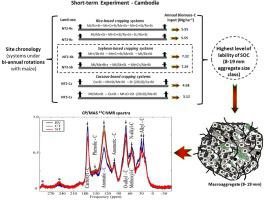Catena ( IF 5.4 ) Pub Date : 2020-12-15 , DOI: 10.1016/j.catena.2020.105065 Lyda Hok , João Carlos de Moraes Sá , Stéphane Boulakia , Manuel Reyes , Ademir de Oliveira Ferreira , Florent Elie Tivet , Sergio Saab , Ruben Auccaise , Thiago Massao Inagaki , Rafael Schimiguel , Lucimara Aparecida Ferreira , Clever Briedis , Lutécia Beatrizdos Santos Canalli , Rada Kong , Vira Leng

|
No-till (NT) cropping systems have the potential to enhance soil aggregation, providing physical protection and soil C sequestration. The existence of discrepancies in the impact of tillage on soil aggregation and soil C sequestration warrants further studies, particularly for different crop rotations. We hypothesized the following: a) NT biannual crop rotations tend to be more effective in restoring large macroaggregation and the concentrations of soil organic C (SOC), total N and permanganate oxidizable C (POXC) associated with macroaggregates than NT systems with a one-year frequency pattern and conventional tillage (CT); b) the continuous biomass-C inputs via crop residues in large macroaggregates under NT tend to increase the proportion of aliphatic C than those under CT. Therefore, the objectives of this study were: (i) to assess changes in the aggregate size distribution and levels of aggregate-associated total SOC, total N and POXC and (ii) to characterize humic acid (HA) using 13C CP-MAS nuclear magnetic resonance (NMR) spectra of 8- to 19-mm soil aggregate size class in a reference vegetation (RV) and in rice-, soybean- and cassava-based cropping systems (RcCS, SbCS and CsCS, respectively) in a clayed Oxisol after tillage and crop rotation management. We evaluated four treatments in each cropping system: 1) CT, and 2) three NT systems in a randomized complete block design with three replicates. Soil aggregate samples were collected at depths of 0–5, 5–10 and 10–20 cm. The conversion of RV to agricultural land influenced the distribution of aggregate size classes, soil aggregation indices and aggregate-associated SOC, total N and POXC in the two surface layers. The formation of large macroaggregates (8–19 mm) dominated the aggregate size distribution with a relatively higher proportion under RV and NT than under CT. Across all soil depths, the proportions of the 8- to 19-mm aggregate size fraction were 59% (NV), 43% and 47% (RcCS), 45% and 53% (SbCS) and 34% and 37% (CsCS) for the CT and NT systems, respectively. Among the three NT systems, the biannual crop rotations in the three cropping systems (NT2-Rice, NT2-Soybean, NT2-Cassava; NT3-Rice, NT3-Soybean and NT3-Cassava) indicated better performance than the one-year frequency pattern in restoring large macroaggregation and the concentrations of SOC, total N and POXC associated with large macroaggregates. Additionally, in the surface (0–5 cm) and subsurface (10–20 cm) soil layers, the SbCS with a high rate (7.32 Mg C ha−1 year−1) and diversity [Pennisetum typhoides) (Pearl millet)/maize + Brachiaria ruziziensis (Brz), Stylosanthes guianensis (St)] of biomass-C inputs reached the highest levels of lability of SOC and POXC in the macroaggregate size classes of 0.25–0.5 and 8–19 mm, respectively. The CP-MAS 13C NMR measurement suggests that the continuous and high biomass-C inputs with diverse crop residues under NT, such as millet, maize, Brz, St and Crotalaria juncea, tended to increase the proportion of aliphatic C than under CT; an opposite trend was observed for aromatic C. 13C NMR revealed an advance caused by the association between the quantity and quality of C addition via cultural residues in the discrimination of the composition of C in the macroaggregation in the tropical region.
中文翻译:

柬埔寨稀树草原生态系统保护农业下基于多样性和高生物量碳输入的土壤团聚体相关有机碳动态
免耕(NT)种植系统具有增强土壤聚集,提供物理保护和固碳的潜力。耕作对土壤聚集和固碳的影响差异的存在值得进一步研究,特别是对于不同的作物轮作。我们假设以下情况:a)NT一年两次的轮作在恢复大型宏观聚集体方面以及与宏观聚集体相关的土壤有机碳(SOC),总氮和高锰酸盐可氧化碳(POXC)的浓度往往比具有一氧化氮的NT系统更有效。年频率模式和常规耕作(CT);b)在NT下,通过大型宏观聚集体中的作物残渣连续输入生物量C的趋势往往比CT下增加了脂肪族C的比例。因此,本研究的目标是:13在参考植被(RV)和水稻,大豆和木薯为基础的种植系统(分别为RcCS,SbCS和CsCS)中,土壤团聚体大小级别为8至19毫米的C CP-MAS核磁共振波谱)在耕作和轮作后进行黏土处理。我们在每个种植系统中评估了四种处理方法:1)CT和2)三个随机重复的完整块设计中的三个NT系统。在0–5、5–10和10–20 cm的深度收集土壤骨料样品。RV向农用地的转化影响了两个表层的团聚体大小类别,土壤团聚指数和与团聚体相关的SOC,总氮和POXC的分布。大型大骨料(8-19 mm)的形成在骨料粒度分布中占主导地位,在RV和NT下比在CT下相对更大。在所有土壤深度中,8到19毫米的骨料比例分别为59%(NV),43%和47%(RcCS),45%和53%(SbCS)和34%和37%(CsCS) )分别用于CT和NT系统。在这三个NT系统中,三个种植系统(NT2-水稻,NT2-大豆,NT2-木薯; NT3-水稻,NT3-大豆和NT3-木薯)的半年轮作显示,其表现优于一年频率模式恢复大型宏观聚集体以及与大型宏观聚集体相关的SOC,总氮和POXC的浓度。此外,在表层(0–5 cm)和地下(10–20 cm)土壤层中,SbCS的速率较高(7.32 Mg C ha 分别。在这三个NT系统中,三个种植系统(NT2-水稻,NT2-大豆,NT2-木薯; NT3-水稻,NT3-大豆和NT3-木薯)的半年轮作显示,其表现优于一年频率模式恢复大型宏观聚集体以及与大型宏观聚集体相关的SOC,总氮和POXC的浓度。此外,在表层(0–5 cm)和地下(10–20 cm)土壤层中,SbCS的速率较高(7.32 Mg C ha 分别。在这三个NT系统中,三个种植系统(NT2-水稻,NT2-大豆,NT2-木薯; NT3-水稻,NT3-大豆和NT3-木薯)的一年两次轮作显示,表现优于一年频率模式恢复大型宏观聚集体以及与大型宏观聚集体相关的SOC,总氮和POXC的浓度。此外,在表层(0–5 cm)和地下(10–20 cm)土壤层中,SbCS的速率较高(7.32 Mg C ha−1年−1)和生物量-C输入的多样性[鼠伤寒](珍珠小米)/玉米+ 腕果Brachiaria ruziziensis(Brz),Stylosanthes guianensis(St)]达到了SOC和POXC不稳定性的最高水平等级分别为0.25–0.5和8–19 mm。CP-MAS 13 C NMR测量表明,在NT下连续和高生物量C的输入具有多种作物残留,例如小米,玉米,Brz,St和Cretalaria juncea,与CT相比倾向于增加脂肪族C的比例。芳香族C观察到相反的趋势。13C NMR揭示了由于通过文化残留物添加C的数量和质量之间的联系而引起的进展,该区别是对热带地区大型聚集体中C组成的区分。











































 京公网安备 11010802027423号
京公网安备 11010802027423号